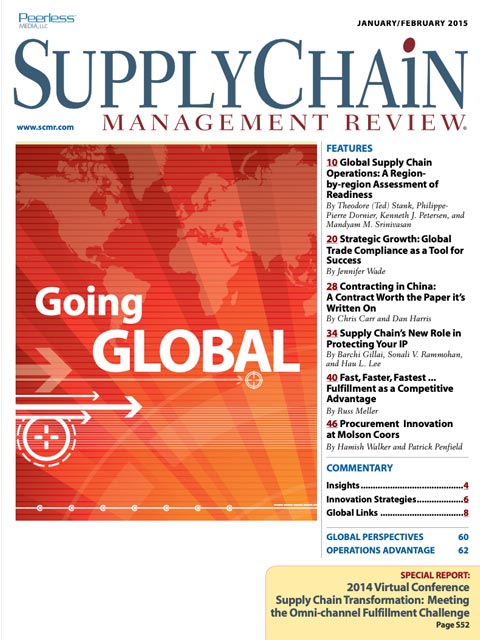Sorry, but your login has failed. Please recheck your login information and resubmit. If your subscription has expired, renew here.
January-February 2015
As long as there have been boats and beasts of burden, intrepid business professionals, governments, and marauders have sought fame, fortune, wealth, and value by going global. Think the Phoenicians, Marco Polo, and the Vikings in days of old. Or in contemporary times, think of China, BRIC, EMEA, and other emerging markets. One could argue that outsourcing to China a few decades ago gave birth to supply chain management as we think of it today. This month we’re including an online bonus column from APQC. While this issue focuses on global management, we didn’t want to miss out on the column. Browse this issue archive.Need Help? Contact customer service 847-559-7581 More options
Global sales opportunity—or supply chain snafu? Too often, the two go together when an organization embarking on global expansion discovers that its shipment is out of compliance with a trade regulation that had not been considered in advance.
When this happens, the story is almost always the same: “An overseas opportunity came up and we made a deal. But we ignored the fact that we had to cross an international border, and now our goods are hung up at Customs, we’re paying warehouse fees that we didn’t plan on, and we’ve just learned that someone has to go down and mark the goods.”
Even today, in what’s clearly a worldwide economy, that’s how many companies embark on doing business globally. They probably have the “bones” of a global supply chain firmly in place, but they may lack the trade compliance programs that can make or break their cross-border supply chain activities. At best, they get themselves into all kinds of trade compliance hassles; at worst, they see those hassles as a sign that any further expansion into foreign markets is not worth it.
 |
This complete article is available to subscribers
only. Click on Log In Now at the top of this article for full access. Or, Start your PLUS+ subscription for instant access. |
SC
MR
Sorry, but your login has failed. Please recheck your login information and resubmit. If your subscription has expired, renew here.
January-February 2015
As long as there have been boats and beasts of burden, intrepid business professionals, governments, and marauders have sought fame, fortune, wealth, and value by going global. Think the Phoenicians, Marco Polo, and… Browse this issue archive. Access your online digital edition. Download a PDF file of the January-February 2015 issue.
 |
Download Article PDF |
Global sales opportunity—or supply chain snafu? Too often, the two go together when an organization embarking on global expansion discovers that its shipment is out of compliance with a trade regulation that had not been considered in advance.
When this happens, the story is almost always the same: “An overseas opportunity came up and we made a deal. But we ignored the fact that we had to cross an international border, and now our goods are hung up at Customs, we’re paying warehouse fees that we didn’t plan on, and we’ve just learned that someone has to go down and mark the goods.”
Even today, in what’s clearly a worldwide economy, that’s how many companies embark on doing business globally. They probably have the “bones” of a global supply chain firmly in place, but they may lack the trade compliance programs that can make or break their cross-border supply chain activities. At best, they get themselves into all kinds of trade compliance hassles; at worst, they see those hassles as a sign that any further expansion into foreign markets is not worth it.
 |
SUBSCRIBERS: Click here to download PDF of the full article. |
SC
MR


Latest Supply Chain News
Latest Podcast

 Explore
Explore
Latest Supply Chain News
- AdventHealth named top healthcare supply chain by Gartner
- Geopolitical readiness in supply chains: Strategic challenges for leaders
- Unlocking retention: The role employee engagement plays
- Can supply chain managers embrace an entrepreneurial mindset?
- Challenges to ESG reporting
- With capacity to spare, logistics real estate demand remains subdued
- More latest news
Latest Resources

Subscribe

Supply Chain Management Review delivers the best industry content.

Editors’ Picks





